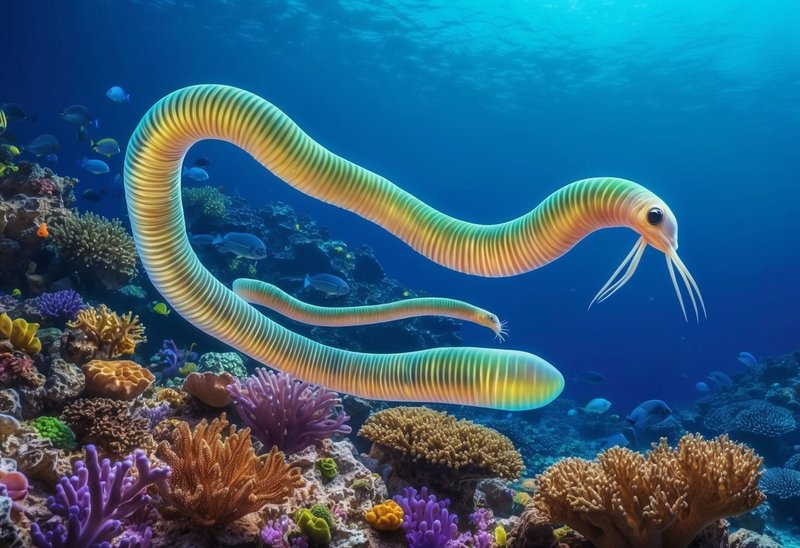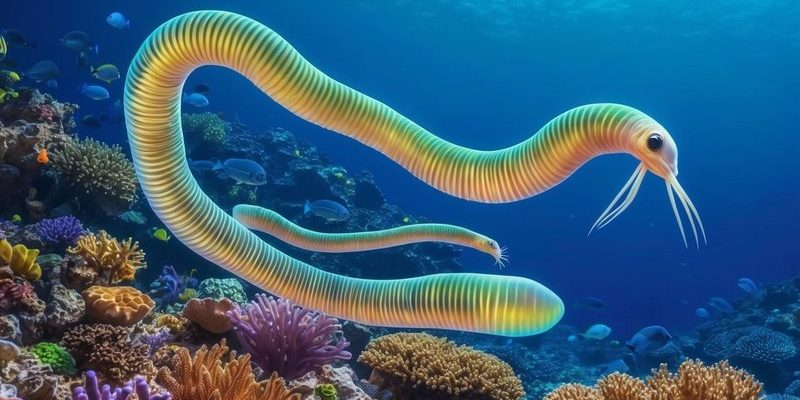
Infrared cameras are equipped to capture heat signatures, letting you see creatures even in the dark depths of the ocean. Brands like FLIR and Seek Thermal have made these cameras more accessible, allowing marine enthusiasts and researchers alike to explore the underwater realm. Whether you’re a curious amateur or a seasoned scientist, this technology can open a new window into marine exploration. Let’s dive deeper into how to use infrared cameras effectively to watch bobbit worms and why it matters.
What Are Bobbit Worms?
Bobbit worms, known scientifically as *Eunice aphroditois*, are truly impressive creatures that can grow up to ten feet long! These marine worms are not only fascinating due to their size but also because of their unique hunting abilities. They wait in the sand, camouflaged and ready to strike at unsuspecting prey that swims too close. With their razor-sharp jaws, they can snap up fish and even larger marine animals in the blink of an eye.
Here’s the thing: bobbit worms are often overlooked in marine studies, mainly because they live hidden away. Their secretive nature makes them hard to study using traditional observation methods. This is where infrared cameras shine. By using these cameras, we can observe the worms’ hunting behaviors and interactions without disrupting their environment, gaining insights into their role in the ecosystem.
It’s easy to understand why many people find bobbit worms both frightening and intriguing. Imagine spotting a creature that looks like it’s from another planet, with bright colors and unusual movements. Observing their behavior can change how we see these fascinating creatures, turning fear into fascination.
How Infrared Cameras Work
So, how do infrared cameras actually work? These devices detect heat emitted from objects, allowing you to see them even in complete darkness. Unlike regular cameras that rely on light, infrared cameras pick up thermal radiation, making it possible to visualize heat signatures. This is particularly useful for spotting animals like bobbit worms, which may be hidden under the sand or in crevices.
When using an infrared camera, you’re essentially seeing a different spectrum of color. Hotter objects will appear brighter, and cooler areas will show up as darker shades. This contrast helps you distinguish between various marine life and their surroundings. If a bobbit worm is nestled in the sand, for instance, its heat signature will stand out against the cooler ocean floor.
By understanding how these cameras function, you can make the most of your observations. Positioning the camera correctly, adjusting settings, and learning to interpret the thermal images can take some practice, but it’s worth the effort. You might end up capturing an unbelievable moment, like a bobbit worm launching itself to catch its next meal!
Choosing the Right Infrared Camera
With so many infrared cameras available, choosing the right one can be a bit overwhelming. You want something that’s not only effective but also user-friendly, especially if you’re just starting out. A good camera will have a decent resolution, a reasonable battery life, and features that allow for easy pairing with devices like smartphones.
For example, brands like FLIR offer handheld models perfect for beginners. The FLIR One has a thermal imaging capability that syncs easily with your smartphone, giving you an intuitive interface to work with. It’s compact, making it convenient for underwater exploration.
When picking a camera, consider the following key features:
- Resolution: Higher-resolution cameras provide clearer images, helping you see the details better.
- Battery Life: Some cameras can last longer than others; a good battery ensures you won’t miss those critical moments.
- Compatibility: Make sure the camera can pair well with your devices for easier access.
Taking the time to research and choose the right camera can make your observations of bobbit worms not only successful but also exciting!
Setting Up for Observation
Once you’ve got your infrared camera, it’s time to set up for your bobbit worm observation. First things first, you’ll want to find the right location. These worms typically inhabit sandy substrates in shallow tropical marine environments. Places like coral reefs or sandy bottoms near mangroves can be excellent spots.
When you arrive, it’s important to remain as still and quiet as possible. Any sudden movements or loud noises can scare the creatures away, ruining your chance to observe. Position your camera, making sure it’s secure, and adjust the settings to capture the best possible image.
As you start recording, keep an eye on the screen for any heat signatures. You might be surprised by how many creatures you can see! And remember, patience is key. Watching bobbit worms in action may take time, as they can be slow-moving and often spend long stretches buried in the sand.
Interpreting Your Footage
After capturing your bobbit worm footage, the real fun begins: interpreting what you’ve recorded. Understanding the behavior of bobbit worms can offer fascinating insights. For instance, you might observe how they interact with other marine life or the techniques they use when hunting.
Watch closely for their hunting technique. When prey approaches, they might strike with incredible speed, showing off their predatory skills. This kind of footage can help you better appreciate the role these worms play in their ecosystem and contribute to your understanding of marine biology.
Keep a notebook handy. Jotting down your observations while watching the footage can help you track patterns over time. Maybe you’ll notice certain times of day when the worms are more active. This can lead to exciting discoveries and a deeper appreciation for these remarkable creatures.
The Importance of Observing Bobbit Worms
Understanding bobbit worms is important for several reasons. First, they play a crucial role in the marine food web. As both predators and prey, they help maintain a balance in their ecosystems. By observing their behaviors, we can learn more about their impact on other marine species.
Additionally, studying bobbit worms can contribute to broader marine conservation efforts. As we learn about their habits, we can also understand the health of their habitats. If bobbit worm populations decline, it may signal problems in the environment that need addressing.
There’s also something incredibly rewarding about exploring life beneath the waves. Observing bobbit worms through infrared cameras can foster a connection to the underwater world, inspiring conservation and a love for these hidden creatures.
Tips for Successful Observations
To make the most of your infrared camera and bobbit worm observations, consider these helpful tips:
1. Be Patient: Marine life can be unpredictable. Give yourself plenty of time to wait for the action.
2. Practice Camera Techniques: Familiarize yourself with camera settings and controls before you head out. Understanding how to adjust focus, brightness, and contrast can greatly improve your footage.
3. Do Some Research: Learn about bobbit worm habitats and behaviors. The more you know, the better equipped you’ll be to spot them in action.
4. Share Your Findings: Once you’ve captured some footage, consider sharing it with fellow marine enthusiasts, researchers, or social media. Your observations could contribute to valuable discussions in the scientific community.
Embracing these tips can enhance your experience and make your exploration even more enjoyable.
Ultimately, using infrared cameras to watch bobbit worms unlocks a spectacular world beneath the waves. With a blend of patience, curiosity, and the right technology, you can bring these elusive creatures into focus. By understanding their behaviors and roles in the marine ecosystem, you’re not just observing—you’re participating in a larger conversation about our ocean’s health. So gear up, grab your camera, and let the underwater adventure begin!

